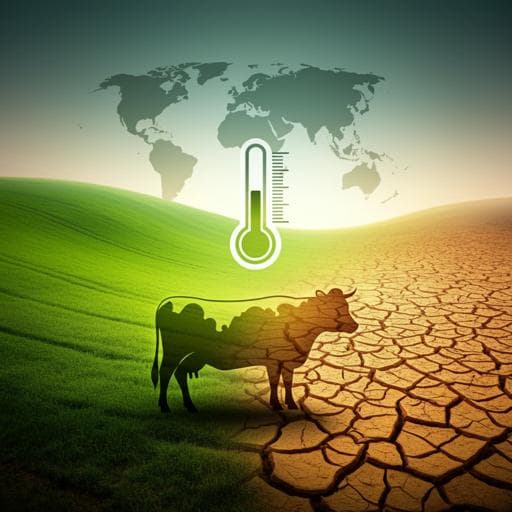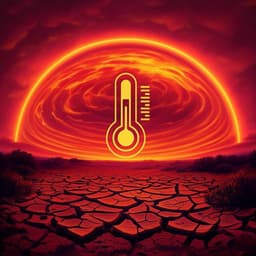
Agriculture
Unequal impact of climate warming on meat yields of global cattle farming
W. Liu, J. Zhou, et al.
This study reveals a fascinating nonlinear relationship between climate warming and global cattle meat yield, showing alarming declines in productivity at higher temperatures. Conducted by Weihang Liu, Junxiong Zhou, Yuchi Ma, Shuo Chen, and Yuchuan Luo, the research highlights growing inequalities in meat production, particularly affecting low-income countries amidst future warming scenarios.
~3 min • Beginner • English
Introduction
The study addresses how anthropogenic climate warming impacts cattle meat yield (meat per animal) globally and whether these impacts are unequally distributed across countries. Given that livestock products contribute substantially to global calories and protein and support the livelihoods of hundreds of millions, understanding climate risks to livestock systems is critical. Prior work highlights that poor and warm countries face disproportionate climate burdens and have limited adaptation capacity. The research aims to quantify the global, country-level response of cattle meat yield to warming, investigate modulation by wind and cloud (cooling effects), assess differences across livestock systems (grassland-based versus others), and evaluate current and future inequality in impacts under climate scenarios.
Literature Review
Evidence indicates climate warming reduces livestock productivity and increases mortality. Experimental and observational studies document heat stress effects on animal health (reduced fertility, suppressed immune function, increased disease), and behavioral/physiological responses (less eating, faster breathing) that reduce energy available for production. Potential heat stress exposure is projected to increase, especially in tropical zones, for many livestock species by century’s end. While species- and region-specific studies exist, global statistical evidence for climate impacts on cattle meat yield at the individual level has been lacking. Cattle meat yield reflects feed availability and conversion efficiency, and relates to greenhouse gas emission intensity. The study positions itself to fill this global evidence gap.
Methodology
Data: Country-level cattle (beef and veal) meat yield (meat with bone, fresh or chilled) from FAOSTAT (1961–2020), defined as total cattle meat weight divided by total number of cattle, representing individual-level productivity. Socioeconomic covariates from the World Bank: GDP per capita (GDPpc), cereal yield (CerY), and livestock production index (LPI) (1961–2020). Climate data (1961–2020): Temperature and precipitation from CRU TS v4.06 (0.5° monthly); wind speed from TerraClimate (4 km monthly); cloud cover from ERA5 (0.25° monthly). Climate variables were masked by the 2010 cattle distribution and aggregated to country level. Future climate: five ISIMIP CMIP6 GCMs (GFDL-ESM4, IPSL-CM6A-LR, MPI-ESM1-2-HR, MRI-ESM2-0, UKESM1-0-LL), bias-corrected and downscaled to 0.5°, under SSP1-2.6 and SSP3-7.0. Land data: Pasture and cropland distributions from EARTHSTAT (10 km). Pasture land productivity via multi-year country-average GPP from MsTMIP (ensemble of 14 models, SG3 runs, 1961–2010). Livestock system classification from FAO (1 km). Modeling framework: Pooled panel regressions with equal country weights to estimate the effect of warming on log meat yield, with robustness checks including production-weighted regressions and alternative fixed-effects specifications. Core models: M1 uses annual mean temperature (T) with a quadratic term to capture nonlinearity; M2 uses temperature-humidity index (THI) as the warming metric. Both include precipitation (P), GDPpc, CerY, LPI, and interactions of warming (T or THI) with wind speed and cloud cover to account for cooling mitigation. Time terms (t and t^2) capture global trends. Equations: log(Y_it) = α_t + α_2 t^2 + β0 + β1 T_it + β2 T_it^2 + β3 T_it × Wind_it + β4 T_it × Cloud_it + β5 P_it + β6 GDPpc_i + β7 CerY_it + β8 LPI_it + ε_it (M1). For M2, T terms are replaced with THI and interactions THI×Wind and THI×Cloud. Grassland-based splits: Countries categorized as grassland-based using three criteria: pasture–cropland ratio (PCR > 50% and > 70%), pasture land productivity thresholds (country-average pasture GPP > 10 g m−2 and > 20 g m−2), and FAO livestock system classification (majority grassland-based). Separate regressions conducted for subsets. Robustness specifications: M3 includes linear THI and frost days (FRS) to separate heat and cold stress, with THI interactions with wind/cloud. M4 uses cumulative hourly THI above thresholds (≥72 moderate, ≥79 high) from ERA5-Land; cumulative exposure metrics interact with wind/cloud. M5–M6 replicate M1–M2 using ERA5 wind. M7–M8 add interaction between warming (T or THI) and livestock water withdrawal (FAO AQUASTAT) to capture cooling via water/shower management. Future projections: Apply M1 and M2 with GCM climate to estimate changes in meat yield for 2081–2100 relative to 1985–2014 under SSP1-2.6 and SSP3-7.0, assuming no future technical progress.
Key Findings
- Global response is nonlinear (inverted U): Cattle meat yield increases from low to moderate temperatures, then declines beyond an optimal threshold; similar pattern when using THI. Warming in colder regions can increase yield, while in hotter regions it reduces yield. - The marginal effect of 1 °C warming on cattle meat yield is consistently negative across eight models, ranging from about −0.76% to −0.12%. - Wind and cloud mitigate heat stress: Including interactions raises estimated optimal thresholds relative to models without wind/cloud. The Bowen ratio shows negative associations with cloud cover (r = −0.39, p < 0.10) and wind speed (r = −0.51, p < 0.10), indicating enhanced latent cooling with more cloud and wind. - Grassland-based systems exhibit greater sensitivity to warming than mixed/cropland-feed systems across multiple splitting methods (FAO classification, pasture–cropland ratio, and pasture GPP). - Socioeconomic and hydrometeorological drivers: Higher precipitation, GDP per capita, cereal yield, and LPI are associated with higher meat yields (e.g., in M1, positive and significant coefficients for P, GDPpc, CerYield, LPI; adjusted R^2 ≈ 0.33–0.34). - Country heterogeneity: Among the top 10 producers, warming increases yield in Russia (cold baseline), but reduces yield in 7 of 10; the U.S. and China show mixed effects due to proximity to optimal temperatures. Under THI, only the U.S., China, and Russia show positive associations with THI anomalies. - Inequality by income: In low-income countries, a 1 °C warming corresponds to about 1% average yield loss, whereas high-income countries experience about −0.2%. A 1-unit increase in THI corresponds to approximately −0.7% in low-income countries and ~0% in high-income countries. - Future projections: Unequal impacts intensify under higher emissions. The largest difference in yield losses between low- and high-income countries reaches 3.2% under SSP3-7.0 by 2081–2100 relative to 1985–2014. Spatially, larger losses occur in low- and mid-latitudes. Globally, climate warming alone (no management change) reduces average cattle meat yield by about 3.7% under SSP3-7.0 by century’s end.
Discussion
Findings demonstrate a nonlinear, climate-driven constraint on cattle meat yield, with wind and cloud cover moderating heat stress via enhanced latent cooling. The stronger sensitivity in grassland-based systems reflects direct exposure of animals and forage to climatic extremes and limited management interventions compared to cropland-feed systems (e.g., irrigation cooling, supplemental feed). Results provide a livestock-based mechanism supporting macroeconomic studies of nonlinear temperature effects on economic output by identifying animal performance and feed intake as key channels. Inequality emerges because baseline temperatures differ across regions: warming exacerbates heat stress in already hot, often lower-income countries with limited adaptive capacity, while colder, higher-latitude countries may benefit or face smaller losses. Mechanistically, heat stress reduces immunity and fertility, increases disease risks, lowers feed intake, accelerates respiration, and diverts energy from growth, while concurrent drought and high VPD reduce rangeland productivity and increase water demand, compounding impacts. Despite the relatively modest projected global-average yield reduction compared to long-term technological gains, the distributional consequences are significant, underscoring the need for targeted adaptation to protect vulnerable regions and systems.
Conclusion
This study provides global statistical evidence that cattle meat yield responds nonlinearly to climate warming and that impacts are unequally distributed across countries and livestock systems. Wind and cloud cover mitigate heat stress; grassland-based systems are more sensitive than mixed/cropland-feed systems. Low-income and hotter countries face larger current and projected losses, with inequality widening under higher-emission scenarios (e.g., up to 3.2% greater losses in SSP3-7.0). Policy and management should prioritize adaptation in vulnerable regions, including heat-tolerant breeds, improved housing (shade, showers), disease prevention, irrigation and forage management for cropland-feed systems, and water provision during hot-dry conditions. Future research should incorporate supply chain disruptions, labor impacts, behavioral adaptations (grazing patterns/timing), finer subnational analyses, and potential tipping points, and evaluate the effectiveness and scalability of adaptation strategies under different socioeconomic pathways.
Limitations
- Outcome represents individual-level productivity (meat per animal) and does not capture herd dynamics or total production directly. - Country-level empirical approach may miss within-country behavioral adaptations (e.g., grazing timing, redistribution), and historical responses may not predict future tipping points. - Data gaps and discontinuities exist in some developing countries, introducing uncertainty. - Projections assume no future technological progress or management changes, likely overestimating climate-driven yield losses relative to adaptive futures. - Climate shocks to global livestock supply chains (transport disruptions, infrastructure damage), labor availability, and disease dynamics were not quantified, though they can propagate additional impacts. - Model estimates rely on aggregated country-level climate and management proxies and may not capture microclimate or facility-level interventions. - Results depend on bias-corrected GCM projections and the selected scenarios (SSP1-2.6, SSP3-7.0).
Related Publications
Explore these studies to deepen your understanding of the subject.







